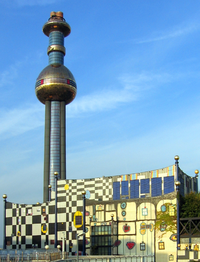
Photo from wikipedia
Abstract Despite the commercial importance of understanding how fruit trees respond to differences in temperature between sites and due to global warming, direct experimental field studies of temperature effects on… Click to show full abstract
Abstract Despite the commercial importance of understanding how fruit trees respond to differences in temperature between sites and due to global warming, direct experimental field studies of temperature effects on whole trees have been uncommon. To perform such studies, considerable information is needed regarding the technical aspects of heating. Thus, the objective of this study was to design and test an active heating system with two complementary heating methods that can be used for evaluating the responses of young fruit trees such as olive to warming. The two complementary methods employed to actively heat open top chambers (OTCs) were a common electrical resistance method (i.e., space heaters) and a simple transparent plastic sleeve design with blackened stones inside through which air was forced to heat the OTCs. Similar OTCs with plastic sidewalls were used as controls. The daily course of air temperature in both types of OTC tracked that of ambient air temperature. The average daily air temperature in the control OTCs was about 1 °C greater than ambient temperature due to passive heating associated with the sidewalls. The solar heated, plastic sleeve with blackened stones proved to be an effective method for daytime warming of the OTCs in the summer, but not in the autumn when solar radiation was low. In contrast, heating with the space heaters was critical on cloudy days and at night when the plastic sleeve heating was insufficient or negligible. On average, the actively heated OTCs were about 3.5 °C warmer than the control OTCs in both summer and autumn. Microclimatic variables including absolute humidity, carbon dioxide concentration, and photosynthetically active radiation were similar between the passively and actively heated OTCs. Initial observations showed that vegetative growth and yield of young olive trees were similar under ambient outdoor conditions and when passively heated by 1 °C, which suggests that chamber effects were small. The detailed evaluation conducted should provide some methodological foundation for future agricultural and physiological studies of young fruit tree responses to warming.
Journal Title: Scientia Horticulturae
Year Published: 2019
Link to full text (if available)
Share on Social Media: Sign Up to like & get
recommendations!